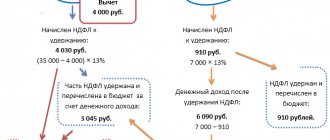Types of tax periods
According to paragraph 1 of Article of the Tax Code of the Russian Federation, the tax period is a period of time at the end of which the final tax base is determined and the final amount of tax is calculated, which must be transferred to the budget.
The specific tax period for each tax is established in Part 2 of the Tax Code (in the chapter devoted to the relevant tax). This period varies from a month to a year. The period of time at the end of which you need to calculate the total amount of the trading fee is called the taxation period, and the insurance premiums are called the settlement period.
Fill out, check and submit a new insurance premium calculation online for free
What is the responsibility for violating the deadlines for submitting these reports?
Having found out how a report should be prepared, what a reporting and billing period is and what the difference is, you need to clarify the issue of responsibility. Any violation: failure to submit accounting reports, delay or provision of false information is punishable by law. If a company delays delivery without a valid reason, then according to paragraph No. 1, Article No. 119 of the Tax Code of the Russian Federation, penalties are equal to 5% of the amount of tax or contribution. Even if the transfer amount is small, the fine cannot be less than 1 thousand rubles. There are limitations to this issue. Penalties cannot exceed 30% of the unpaid amount.
Article No. 116 states that inspectors have the right to impose fines if accountants provide false or inaccurate information. There, prices already depend on the severity of non-connections. If there is no 2-NDFL certificate, then for each form that is not provided you will have to pay two hundred rubles. In the absence of 6-NDFL, the penalty for each certificate is already one thousand rubles. In addition, the inspector can block current accounts, which will affect the operation of the entire enterprise. This right of inspection is provided for in paragraph No. 3, Article No. 76 of the Tax Code of the Russian Federation.
Responsibility
The reporting tax period is a time period during which all taxpayers are required to submit declarations and reports. This issue is regulated by the Tax Code, Article No. 393. There are certain forms that every accountant must follow when drawing up documents. The structure was edited several times, but in the end the balance sheet form was approved by order No. 61n dated April 19, 2019.
How is the tax period determined?
We have compiled data on the duration of periods for all taxes, as well as insurance premiums and trading fees, into a table.
| Length of period | Tax name | Article of the Tax Code of the Russian Federation |
| Month | Excise taxes | 192 |
| MET | 341 | |
| Gambling tax | 368 | |
| Quarter | VAT | 163 |
| Water tax | 333.11 | |
| UTII | 346.30 | |
| Trade fee | 414 | |
| Year | Personal income tax | 216 |
| Income tax | 285 | |
| Tax on additional income from hydrocarbon production | 333.53 | |
| Unified agricultural tax | 346.7 | |
| simplified tax system | 346.19 | |
| PSN (if the patent is issued for a shorter period, the tax period is the period for which the patent was issued) | 346.49 | |
| Transport tax | 360 | |
| Organizational property tax | 379 | |
| Land tax | 393 | |
| Property tax for individuals | 405 | |
| Insurance premiums | 423 |
Submit all tax returns online for free
What does the expression “tax payment period” mean?
The period of tax payments is a time period after the end of the tax period, when taxpayers make tax payments to the budget within a legally defined period. The expression “tax payment deadline” is usually used - it, like the duration of the tax period, is determined by the norms of the Tax Code of the Russian Federation.
Payment deadlines, as a rule, remain unchanged from year to year, and the taxpayer prepares for them in advance in order to pay his tax obligations on time and in full. However, under the pressure of circumstances, corrections are still made. For example, for a tax such as VAT, legislators have repeatedly changed the deadline and procedure for payment in recent years. Some time ago, quarterly calculated VAT amounts were paid by payers of this tax no later than the 20th day of the month following the reporting quarter. Now the payment deadline has been postponed until the 25th, and the amount of VAT payable at the end of the quarter is divided into 3 parts and paid within 3 months in equal installments.
“What is the tax and reporting period for VAT” will help you understand all the nuances of the tax and reporting periods for VAT, as well as find out the specifics of paying it to the budget .
What is the difference between tax and reporting periods
In accordance with paragraph 1 of Article of the Tax Code of the Russian Federation, a tax period may consist of one or more reporting periods. For example, it could be a month, two months, three months, etc., first quarter, second quarter, third quarter, half a year, 9 months. At the end of each reporting period, the taxpayer determines the interim base and contributes the amount of the advance payment to the budget.
As you can see, tax and reporting periods differ in the basis for calculating the amount that needs to be transferred at the end of the corresponding period of time. For the reporting period, this is a kind of “incomplete” base. It can be calculated based on actual data on income, expenses or payments for an intermediate period of time. Or it can be conditional, that is, determined based on data for previous periods or by calculation method. As for the tax period, the payment is always calculated based on the real financial result for the corresponding period of time.
REFERENCE
There may be situations where the final tax will be less than the advance payments made during the year. In this case, the taxpayer will have an overpayment, which can be returned or offset (Article of the Tax Code of the Russian Federation).
Submit an application for credit or refund of taxes (contributions) via the Internet Submit for free
How to submit a reporting period
Sometimes an organization has to submit reports not for a quarter, half a year or year, but for one month. In this case, you can use a simplified form. The reporting month is the same time period for which you need to provide a consolidated balance sheet for profits, expenses and tax deductions. This document should be drawn up only on the basis of verified information and official papers.
As stated below, such accounting reports must be submitted by March 30-31 of each year. Each accountant must send the completed form not only to the Tax Service, to the Statistics Committee, but also to other government agencies. If audit activities were carried out during the reporting period, then a copy of the report must also be sent to the State Committee. The accountant has the right to provide documentation ahead of schedule, because deadlines for delivery are not established by current legislation. The main thing is that this happens before the end of March. Basic moments:
- You can send the report by email, through your personal account at the Federal Tax Service or by registered letter.
- The form must be signed not only by the chief accountant, but also by the head of the financial department and the director.
- If the balance does not add up, there is no need to send raw numbers. You should report any inconsistencies to the inspector who supervises the organization and ask for assistance.
On a note! Approximate figures will lead to the fact that the balance will not add up and the tax inspector will want to conduct an audit for the entire life of the organization.
Generating, uploading, sending a report
Tax period codes for VAT
The following codes are used in the VAT declaration (Appendix No. 3 to the Procedure for filling out the declaration, approved by Order of the Federal Tax Service dated October 29, 2014 No. ММВ-7-3/ [email protected] ):
| 21 | I quarter |
| 22 | II quarter |
| 23 | III quarter |
| 24 | IV quarter |
| 51 | I quarter during reorganization (liquidation) of the organization |
| 54 | II quarter during reorganization (liquidation) of the organization |
| 55 | III quarter during reorganization (liquidation) of the organization |
| 56 | IV quarter during reorganization (liquidation) of the organization |
Also see “New VAT return form: how to submit reports for the first quarter quickly and without errors.”
Fill out, check and submit a new VAT return through Kontur.Extern Submit for free
Codes of tax periods according to the simplified tax system
The declaration under the simplified tax system uses the following codes (Appendix No. 1 to the Procedure for filling out the declaration, approved by order of the Federal Tax Service dated December 25, 2020 No. ED-7-3 / [email protected] :
| 34 | Calendar year |
| 50 | Last tax period for reorganization (liquidation) of an organization |
| 95 | Last tax period when switching to a different taxation regime |
| 96 | Last tax period upon termination of business activity |
Submit a free notification of the transition to the simplified tax system and submit a declaration under the simplified tax system via the Internet
What is included in the PBO
Interim financial statements are required to consist of a balance sheet and a profit and loss account. The balance sheet is the most important reporting form of a commercial organization. Shows the financial condition of the enterprise as of a specific date. Used to analyze the financial and economic activities of the company.
The profit and loss statement gives an idea of the performance indicators for the selected period, allows you to analyze the financial results obtained by the organization for a specified period of time and compare them with the same period of previous years.
If necessary, other reports are included in the interim reporting of commercial organizations, for example, on cash flows, and an explanatory note to the balance sheet.
Codes of tax periods for income tax
The following codes are used in the income tax return (Appendix No. 1 to the Procedure for filling out the declaration, approved by Order of the Federal Tax Service dated September 23, 2019 No. ММВ-7-3/ [email protected] ):
| 21 | first quarter |
| 31 | half year |
| 33 | nine month |
| 34 | year |
| 35 | one month |
| 36 | two month |
| 37 | three months |
| 38 | four months |
| 39 | five months |
| 40 | six months |
| 41 | seven months |
| 42 | eight months |
| 43 | nine month |
| 44 | ten months |
| 45 | eleven months |
| 46 | year |
| 50 | last tax period during reorganization (liquidation) of the organization |
Fill out and submit a new income tax return online Submit for free
Tax period 34
Code 34 in most cases corresponds to a tax period equal to a calendar year. For example, this is the code that is entered in declarations for the simplified tax system, personal income tax and corporate property tax.
When filling out income tax reporting, you need to take into account the following nuance. In the annual return, code 34 is indicated by those taxpayers who submit returns quarterly. If the organization reports profit monthly, then the final declaration contains the number 46, which also indicates the year.
Financial year as a period for financial analysis of annual financial statements
The main period of financial analysis of financial statements is also the financial year, which follows from the periods for which the facts of economic activity are reflected in them. Based on the annual financial statements, the dynamics and structure of indicators, financial stability, solvency, liquidity, business activity, profitability, capital and cash flows are analyzed.
The essence of such an analysis is to compare the data of one financial year with the indicators of the previous or several previous years.
As a rule, data are recorded at the end of the reporting period. Also, the indicators of the annual financial statements can be compared with those planned indicators, forecasts of which were compiled before the start of the financial year.
Thus, the financial year is characterized from several positions: budgetary, fiscal (tax), economic, accounting and analytical. In Russia, from all these points of view, the period of the financial year is uniform and coincides with the calendar year.
Codes for the accounting reporting period in 2022
In accounting, the reporting period is the period for which the organization must prepare financial statements (clause 4 of PBU 4/99). For annual financial statements, this period is the calendar year - from January 1 to December 31 inclusive. An exception applies to cases of creation, reorganization (except transformation) and liquidation of a legal entity (Clause 1, Article 15 of the Federal Law of December 6, 2011 No. 402-FZ “On Accounting”).
ATTENTION
In financial statements, data on periods is not coded, but is indicated by entering the date, month and year.
The form of the balance sheet (approved by order of the Ministry of Finance dated July 2, 2010 No. 66n) does not provide for coding the reporting period. Specific reporting dates are indicated on the title page and in the table with indicators, rather than period codes. In the same way, that is, without using codes, data on periods is filled out in the form of the Statement of Financial Results.
Prepare, check and submit financial statements to the Federal Tax Service via the Internet Submit for free
What's happened
The reporting date is a specific date from which future reporting should begin. Each accountant is given a certain time period necessary to collect data and record it in tables. It doesn’t matter whether we are talking about the formation of a balance sheet or a transport tax, the reporting period can only mean the time that contains the facts of economic activity. The main reference point is the year, and the intermediate ones are the month and quarter.
Reporting period and date
The time period from January 1 to December 31 is a calendar reporting period. If the dates are different, then such reporting is called a financial year. If we talk about accounting standards, then the formation should occur quarterly, and annual reports should be compiled from the final balance sheet, which will contain indicators: finances, cash and capital flows, property assets. Also, we must not forget about the forms of interim accounting. They must duplicate the final indicators. An exception in this case may be audit certificates.
The chief accountant in an organization must prepare quarterly reports, that is, balance the balance sheet every three months. It is important to understand that the first report, after the company has registered with the tax authorities, will be: registration date - end of the year. That is, if a company began to engage in commercial activities on September 1, then reporting will have to be prepared from this date to December 31 and submitted to the Federal Tax Service.
On a note! The tax period is covered by Article No. 285 of the Tax Code of the Russian Federation.
Differences from the billing period
The reporting period is a quarter, half a year and a year, and the estimated time period implies the interval between these positions, when the accountant has the opportunity to “tweak” the balance and make adjustments. The difference is that if reporting has a strict framework, then the calculation period means the entire time period that contains a specific report. The reporting year is regulated by the Federal Law “On Accounting”, Article No. 14.
Periods, both settlement and reporting, are directly related to insurance and the Pension Fund. Article No. 10 of the Federal Law “On Insurance Contributions to the Pension Fund” mentions that calculations for insurance transfers must be carried out for the entire period of the calendar year.
Difference
Differences from tax
The reporting year is the calendar period from January 1 to December 31. During this period of time, the accounting department must submit an income tax return. Most organizations strive to submit their reports before the new year, but the Tax Services provide some deferral time. Submission after December 31st will not be considered a violation. It all depends on what specific tax is meant. Examples:
- Income tax is due in the first quarter, then in the middle of the month and for the quarter before the last date - December 31.
- If we talk about private individuals who calculate monthly advance payments based on the actual profit received, a month, two months, three months, and so on until the end of the calendar year are recognized.
- At the end of each time period, advance payments must be made.
On a note! In some cases, monthly periods apply.





